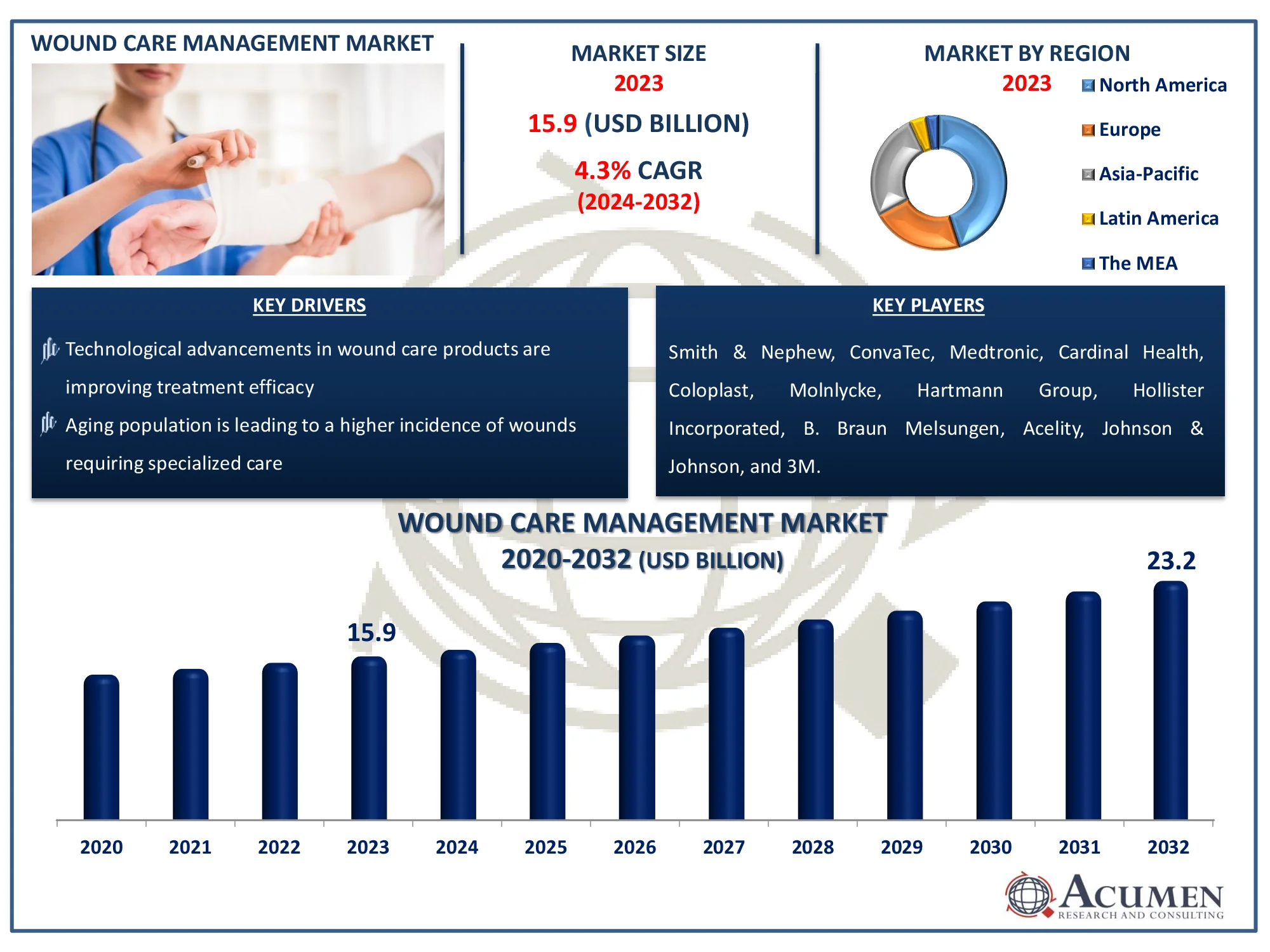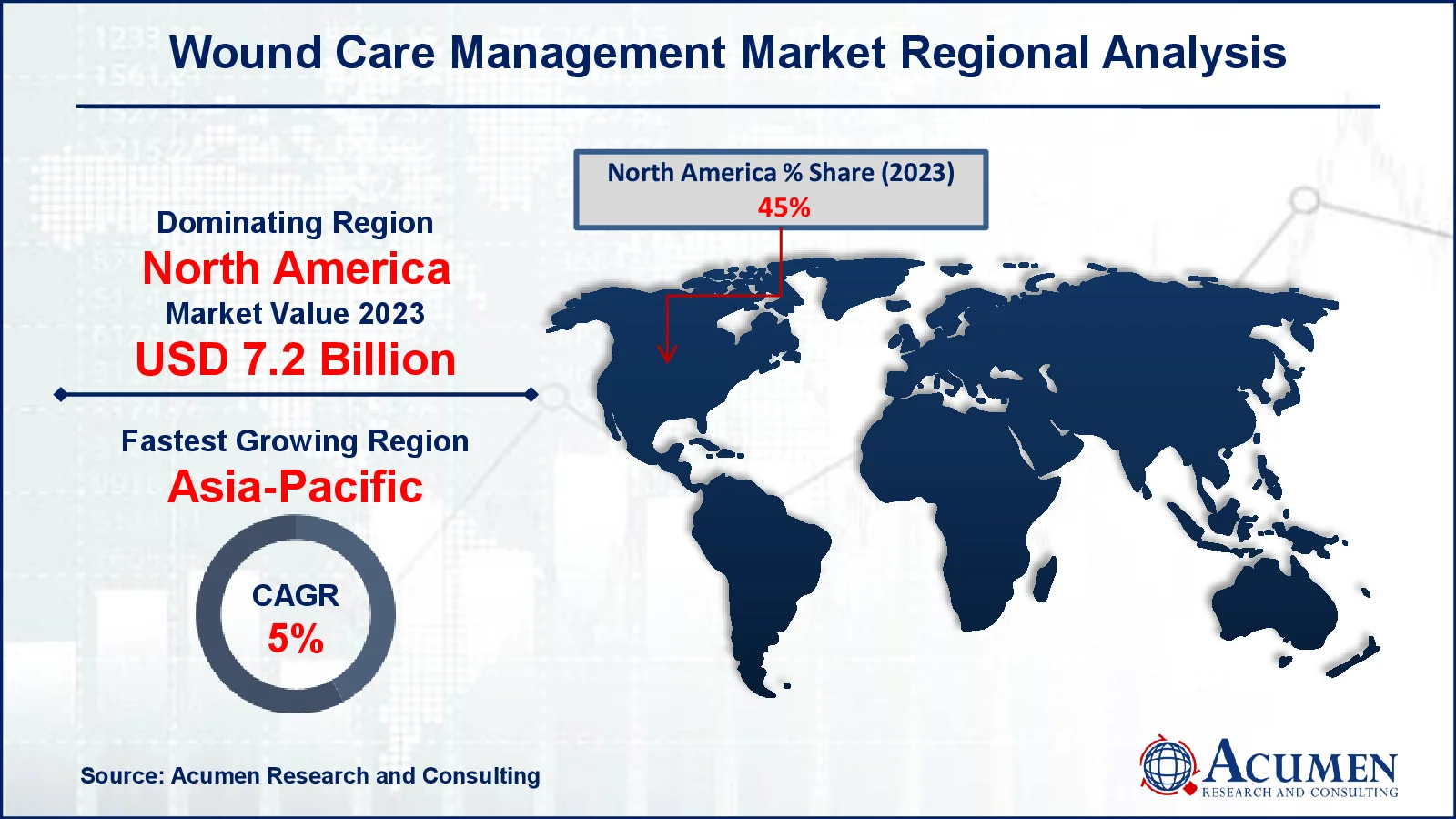December 2018
The Global Wound Care Management Market Size accounted for USD 15.9 Billion in 2023 and is estimated to achieve a market size of USD 23.2 Billion by 2032 growing at a CAGR of 4.3% from 2024 to 2032.
The Global Wound Care Management Market Size accounted for USD 15.9 Billion in 2023 and is estimated to achieve a market size of USD 23.2 Billion by 2032 growing at a CAGR of 4.3% from 2024 to 2032.

Traditional and advanced wound care & closure products are meant to treat delicate and chronic injuries. Chronic injuries are difficult to heal and take a substantial amount of time, and hence are expensive to treat. Advanced wound care products are becoming a standard solution for curing chronic wounds and are increasingly replacing traditional wound care products owing to their better efficiency and usefulness in managing wounds by enabling speedy healing. A wound is a disruption of the normal structure and function of the skin and its architecture. In order to ensure efficient and faster healing of wounds, the wound bed should be vascularized well and should be clear of infection, moisture, and devitalized tissues. Wound dressings should be able to eradicate the dead space, prevent bacterial growth, control exudate, be cost-efficient, and ensure proper fluid balance. Also, it should be feasible to manage for nursing staff and patients.
|
Market |
Wound Care Management Market |
|
Wound Care Management Market Size 2023 |
USD 15.9 Billion |
|
Wound Care Management Market Forecast 2032 |
USD 23.2 Billion |
|
Wound Care Management Market CAGR During 2024 - 2032 |
4.3% |
|
Wound Care Management Market Analysis Period |
2020 - 2032 |
|
Wound Care Management Market Base Year |
2023 |
|
Wound Care Management Market Forecast Data |
2024 - 2032 |
|
Segments Covered |
By Product, By Application, By End User, and By Geography |
|
Regional Scope |
North America, Europe, Asia Pacific, Latin America, and Middle East & Africa |
|
Key Companies Profiled |
Smith & Nephew, Cardinal Health, ConvaTec, Coloplast, Molnlycke, Hartmann Group, Medtronic, Hollister Incorporated, B. Braun Melsungen, Acelity, Johnson & Johnson, and 3M. |
|
Report Coverage |
Market Trends, Drivers, Restraints, Competitive Analysis, Player Profiling, Covid-19 Analysis, Regulation Analysis |
Attempts to reduce the duration of hospital stays in order to reduce healthcare expenditure and rising proclivity towards medical products that augment therapeutic outcomes are spurring the growth of advanced wound care & closure products. The risks involved with ineffective wound healing promote the demand for combination dressings, which is replacing traditional wound dressing techniques. Some of the key factors driving the growth of the global wound care management market include increasing government support in terms of funding, a rise in the aging population as well as increasing incidences of chronic ailments such as obesity and diabetes. However, some key aspects such as the high cost of treatment may hamper the growth of the global wound care management market, especially in developing and cost-sensitive economies.
 Wound Care Management Market Segmentation
Wound Care Management Market SegmentationThe worldwide market for wound care management is split based on product, application, end user, and geography.
According to wound care management industry analysis, advanced wound care emerges as the leading category due to its better efficacy in treating complex and chronic wounds. This market comprises items such as hydrocolloid dressings, foam dressings, alginate dressings, and hydrogels, all of which aid faster healing by retaining moisture and increasing oxygen flow. Advanced wound care treatments are increasingly preferred over traditional techniques because they reduce infection risk, improve patient comfort, and reduce scarring. The rising prevalence of chronic conditions such as diabetes and venous leg ulcers raises demand for these products. Furthermore, improvements in bioengineered dressings and the use of antimicrobial technologies have made advanced wound care a key alternative for healthcare practitioners around the world.
Diabetic ulcers have emerged as the dominant application category in the wound care management market, owing mostly to the global increase in diabetes prevalence. These ulcers, which are frequently a consequence of poorly managed diabetes, necessitate expert care since they can progress to severe, non-healing wounds. Advanced wound care treatments such as tailored dressings and negative pressure wound therapy are commonly used to address diabetic ulcers. The growing awareness of the critical need for fast and effective treatment to avoid amputation has accelerated the uptake of novel wound care options. Furthermore, the expanding senior population, which is more prone to diabetes-related illnesses, has raised this segment's market popularity significantly.
Hospitals are the most important end users in the wound care management market forecast period due to their comprehensive treatment capabilities and advanced facilities. Hospitals usually have cutting-edge technologies, trained healthcare workers, and multidisciplinary approaches to wound management. Patients with serious or chronic wounds, such as diabetic ulcers, pressure ulcers, and burns, usually seek hospital care for specialized procedures such as surgeries and advanced therapies. Furthermore, the expanding number of surgical procedures and trauma patients has raised the need for hospitals to offer effective wound care. The availability of inpatient treatment, combined with sophisticated diagnostic and therapeutic alternatives, cements hospitals as the global preferred choice for wound therapy.
North America
Europe
Asia-Pacific
Latin America
The Middle East & Africa
 Wound Care Management Market Regional Analysis
Wound Care Management Market Regional AnalysisNorth America leads the wound care management market, owing to sophisticated healthcare infrastructure, broad acceptance of innovative technologies, and a high incidence of chronic wounds. The demand for advanced wound care solutions is driven by factors such as an aging population and an increase in diabetes and obesity rates. The region also benefits from substantial healthcare spending, solid reimbursement rules, and ongoing R&D efforts. The existence of large market players increases the accessibility and availability of improved wound care products in North America.
Asia-Pacific, on the other hand, is the market's fastest-growing region, with a 5% CAGR forecast. This development is being driven by rising healthcare knowledge, an increase in the prevalence of chronic diseases, and advances in healthcare infrastructure in emerging economies such as India and China. Government measures to improve healthcare facilities, together with an expanding middle class and increasing disposable income, are hastening the adoption of improved wound care therapies. Furthermore, the expanding senior population and medical tourism are propelling the industry forward. Asia-Pacific is expected to sustain its strong growth rate in the next years, with an emphasis on cost-effective solutions and the adoption of innovative technologies.
Some of the top wound care management companies offered in our report include Smith & Nephew, Cardinal Health, ConvaTec, Coloplast, Molnlycke, Hartmann Group, Medtronic, Hollister Incorporated, B. Braun Melsungen, Acelity, Johnson & Johnson, and 3M.
Looking for discounts, bulk pricing, or custom solutions? Contact us today at sales@acumenresearchandconsulting.com
December 2018
June 2024
October 2018
April 2020